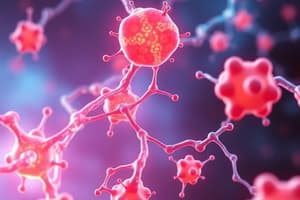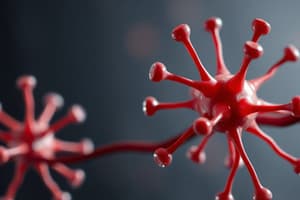Podcast
Questions and Answers
What is the primary function of adrenergic agents?
What is the primary function of adrenergic agents?
- Decrease bronchial constriction
- Increase heart rate and blood pressure (correct)
- Block the normal function of the sympathetic system
- Relax airway smooth muscle
Which of the following is a characteristic of catecholamines?
Which of the following is a characteristic of catecholamines?
- They are used for local bronchodilation
- They have a common basic chemical structure (correct)
- They are used for systemic vasodilation
- They are not destroyed by digestive enzymes
What is the primary effect of norepinephrine on the heart?
What is the primary effect of norepinephrine on the heart?
- Increase heart rate (correct)
- Increase blood pressure
- Decrease heart rate
- Decrease cardiac output
What is the primary effect of phenylephrine on the body?
What is the primary effect of phenylephrine on the body?
What is the primary function of sympatholytics?
What is the primary function of sympatholytics?
What is the primary effect of beta blockers on the heart?
What is the primary effect of beta blockers on the heart?
Which of the following is an example of a sympatholytic drug?
Which of the following is an example of a sympatholytic drug?
What is the primary effect of alpha blockers on the body?
What is the primary effect of alpha blockers on the body?
What is the effect of parasympatholytics on heart rate?
What is the effect of parasympatholytics on heart rate?
Which of the following is a sympathomimetic drug?
Which of the following is a sympathomimetic drug?
What is the mechanism of indirect acting sympathomimetics?
What is the mechanism of indirect acting sympathomimetics?
What is the role of COMT in the life cycle of norepinephrine?
What is the role of COMT in the life cycle of norepinephrine?
What is the effect of sympathomimetics on bronchial smooth muscle?
What is the effect of sympathomimetics on bronchial smooth muscle?
Which of the following is an anticholinergic drug?
Which of the following is an anticholinergic drug?
What is the effect of parasympatholytics on the airways?
What is the effect of parasympatholytics on the airways?
What is the role of reuptake in the life cycle of norepinephrine?
What is the role of reuptake in the life cycle of norepinephrine?
What is the term for drugs that stimulate or mimic the parasympathetic system?
What is the term for drugs that stimulate or mimic the parasympathetic system?
Which of the following drugs blocks or inhibits the sympathetic system?
Which of the following drugs blocks or inhibits the sympathetic system?
What is the effect of stimulation of one system on the other system?
What is the effect of stimulation of one system on the other system?
What is the term for drugs that stimulate or mimic the sympathetic system?
What is the term for drugs that stimulate or mimic the sympathetic system?
Which of the following drugs stimulates or mimics the parasympathetic system?
Which of the following drugs stimulates or mimics the parasympathetic system?
What is the term for drugs that block or inhibit the parasympathetic system?
What is the term for drugs that block or inhibit the parasympathetic system?
What is the relationship between the two systems in terms of balance?
What is the relationship between the two systems in terms of balance?
Which of the following is a characteristic of medications in terms of the two systems?
Which of the following is a characteristic of medications in terms of the two systems?
Flashcards are hidden until you start studying
Study Notes
Sympathomimetic Drugs
- Sympathomimetic drugs can be classified into two subgroups: catecholamines and noncatecholamines.
- Catecholamines include dobutamine, dopamine, epinephrine, and norepinephrine, which have a common basic chemical structure and are destroyed by digestive enzymes if ingested orally.
- Noncatecholamines, such as phenylephrine and albuterol, are used for local or systemic vasoconstriction and bronchodilation.
Sympathomimetic Effects
- Sympathomimetics stimulate the sympathetic system, increasing heart rate (HR), causing pupil dilation, increasing blood flow, and promoting bronchodilation.
Types of Sympathomimetics
- Direct acting sympathomimetics stimulate the release of norepinephrine (NE).
- Indirect acting sympathomimetics prevent the deactivation of NE by inhibiting reuptake and enzyme deactivation.
Norepinephrine (NE) Life Cycle
- NE must be broken down through reuptake, COMT, and MOA.
Sympatholytic Drugs
- Sympatholytics block the normal function of the sympathetic system, decreasing HR, causing bronchoconstriction, and inducing atrioventricular blockade.
- Sympatholytics can have specific adrenergic receptor blockers, such as beta blockers and alpha blockers.
Parasympatholytic Drugs
- Parasympatholytics block ACh stimulation of the parasympathetic receptors, increasing HR and causing bronchodilation.
- Parasympatholytics are pharmacologic antagonists of the parasympathetic system and include anti-muscarinics, such as atrovent and atropine.
ANS Drug Terminology
- Cholinergics, parasympathomimetics, and muscarinics stimulate or mimic the parasympathetic system.
- Anti-cholinergics, parasympatholytics, and anti-muscarinics block or inhibit the parasympathetic system.
- Adrenergics and sympathomimetics stimulate or mimic the sympathetic system.
- Anti-adrenergics and sympatholytics block or inhibit the sympathetic system.
- Stimulation of one system will counter the other system, and both systems work to maintain balance. Medications may stimulate one system more than the other.
Studying That Suits You
Use AI to generate personalized quizzes and flashcards to suit your learning preferences.




